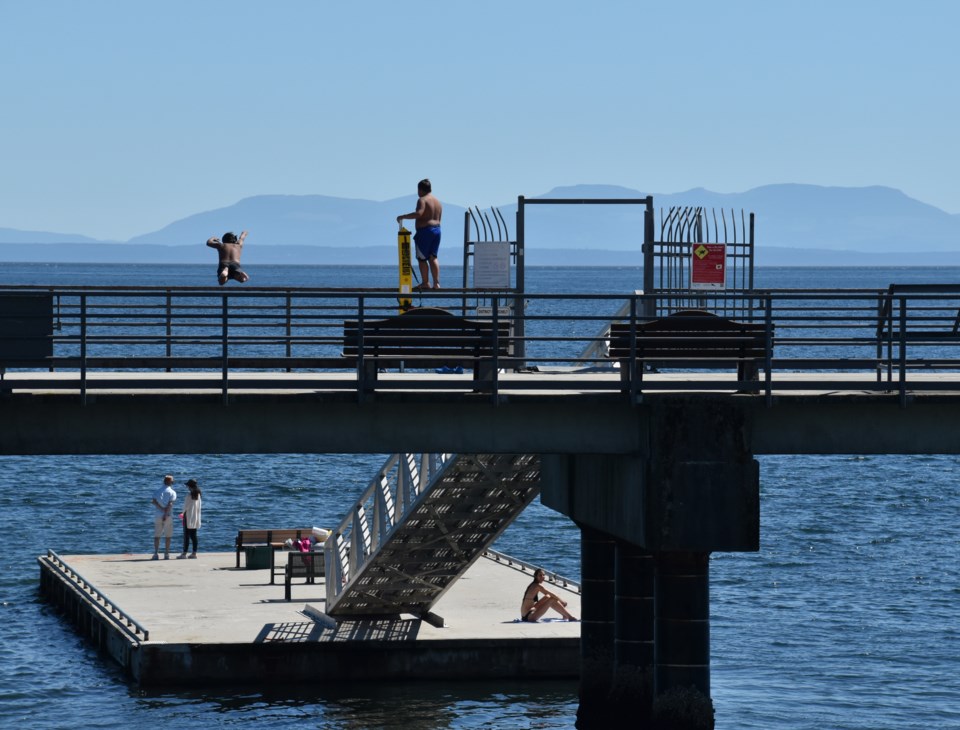Hot weather and lots of it has arrived on the Sunshine Coast in time for the start of summer, but this isn’t any old early summer heat wave – temperatures may be high enough to break all-time records in the coming days.
“A dangerous long duration heat wave will affect B.C. beginning on Friday and lasting until at least Tuesday,” said a warning issued by Environment Canada June 24 for the Sunshine Coast, caused by an “exceptionally strong” high pressure ridge developing over the province.
Warning preparedness meteorologist Armel Castellan told Coast Reporter he expects to see the Sunshine Coast reach “all-time warmest” temperatures in Sechelt or Gibsons on Sunday or Monday.
The highest-ever temperature reached on the Sunshine Coast was 35.6 C in 1965.
“To see those types of temperatures in June is very strange – this pattern doesn’t usually happen then,” Castellan said.
Daytime highs are expected to range from 29 to 37 C during the heat wave – about 10 degrees above normal – with humidex values reaching between the high 30s to low 40s. Overnight lows will drop to between 18 and 20 degrees.
Those temperatures “will increase the potential for heat-related illnesses,” said the warning.
Local medical health officers are expecting an increase in health and safety risks because of the heat, according to the warning.
People are advised to drink water before feeling thirsty, to stay in cool places, check in on older adults and ensure they’re also staying hydrated.
Symptoms of heat illness include feeling faint and dizzy, nausea and vomiting, rapid breathing and heartbeat, extreme thirst and decreased or dark urine.
Those in need of a break from the heat can find respite at cooling centres set up at the Sechelt Aquatic Centre and Roberts Creek Community Hall over the weekend.
The Town of Gibsons has also partnered with the Salvation Army and SuperValu to establish two water stations, one at a bus stop in Lower Gibsons and one in front of Elphinstone Secondary.
Affected areas include the Sunshine Coast and Lower Mainland, Howe Sound, Whistler, Southern Gulf Islands and east and inland Vancouver Island, according to Environment Canada.
The Sunshine Coast has already hit record-breaking temperatures this month. Temperatures reached 28.2 C on June 21 in the Gibsons area, breaking the 26.5 record set in 2004.
On June 1, a 27.2 C record set in 1967 was toppled when the thermometer climbed to 27.8 degrees.
The higher-than-normal temperatures are expected to stick around at least until Wednesday, said Castellan, adding chances of rain won’t be likely in the next couple of weeks. “It’s awhile away,” he said.
The ongoing dryness brings with it an increased risk for wildfires, forcing BC Wildfire Service to respond with burning bans across the province.
On June 23, Coastal Fire Centre prohibited most open burning on public and private land in the Sunshine Coast Forest District, unless local bylaws specify otherwise.
That includes bans on category 2 and 3 open fires, burn barrels, “binary exploding targets,” air curtain burners, fireworks and sky lanterns.
The prohibition doesn’t apply to campfires smaller than a half-metre high by a half-metre wide.
In Sechelt, category 2 and 3 fires are prohibited year-round while campfires for cooking, warmth or ceremonial purposes remain permitted, said Sechelt Fire Chief Trevor Pike, though a complete fire ban, which would include campfires, “should be expected if this weather continues,” he said.
Backyard burning and beach fires are also banned in Gibsons year-round.
Sunshine Coast Regional District (SCRD) manager of protective services Matt Treit said the SCRD will continue following the lead of BC Wildfire Service.
“On behalf of all of our fire chiefs, we are asking that residents and visitors to the region are extra diligent if they are having small campfires,” he said.
People should have a water source close to the fire, ensure it’s out completely when finished and that all debris and waste is cleared before leaving a campfire site. “With this dry weather, a carelessly tossed cigarette butt can spark a fire quickly,” he said.
This week the Coastal Fire Centre put the danger class value for the Sechelt area at 2 or low danger, but predicts that value to increase to moderate danger June 24 and reach high danger from June 26 to 27.
At high danger, “extreme caution” must be used in any forest activities, according to the Wildfire Service.
“Forest fuels are very dry and the fire risk is serious. New fires may start easily, burn vigorously, and challenge fire suppression efforts.”
People can report a wildfire, unattended campfire or open fire violation by calling 1-800-663-5555 or *5555 on a cell phone.



